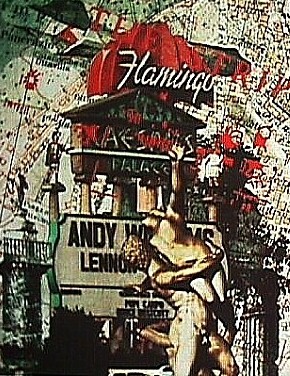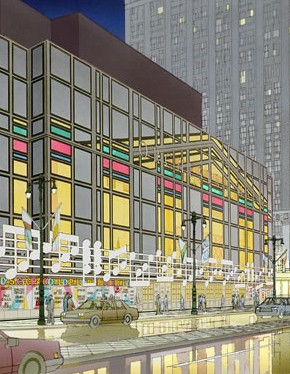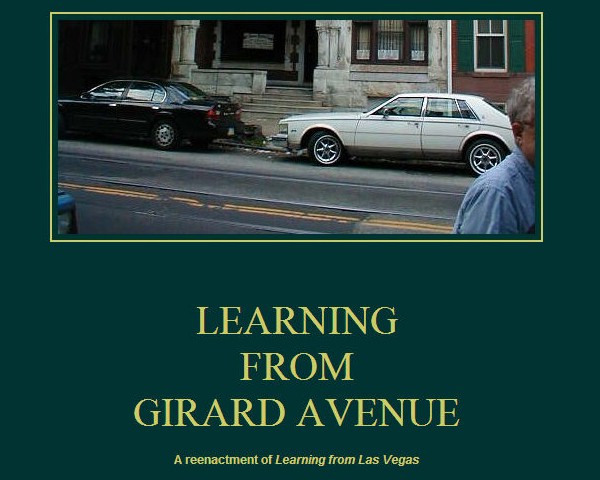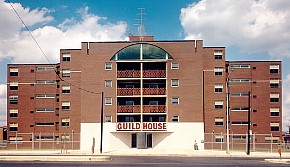2013.07.30 10:29
Learning from Learning from Las Vegas (again)
A sentence within the last paragraph of Scott Brown's 'Preface to the Revised Edition' (1977) gave me pause:
"We feel too that architects, bar a few diehards, are coming to realize that what we learned from Las Vegas, and what they by implication should learn too, is not to place neon signs on the Champs Elysees or a blinking "2 + 2 = 4" on the roof of the Mathematics Building, but rather to reassess the role of symbolism in architecture, and, in the process, to learn a new receptivity to the tastes and values of other people and a new modesty in our designs and in our perception of our role as architects in society."
Pause because I immediately thought of two instances where work of 'the firm' appears to contradict what should "not" be done.

Venturi and Rauch, Roma Interrotta: Sector VII (1978).
Neon signs at the Roman Forum? Perhaps not just that, but also an indication of how the Las Vegas billboard is 'today's' symbolic equivalent. Maybe, maybe not, or perhaps the Rape the the Sabine Women scupture up in front subliminally delivers a more potent symbolic message. Anyway, the fact remains that Venturi and Rauch sought out this particular section of the Nolli map--"One of the last episodes between Giurgola and Venturi occurred at the very beginnings of Roma Interrotta. When each of the invited architects received their section of the Nolli map of Rome, they also got to see what sections the other invited architects received. The Venturi office preferred the section received by the Giurgola office, so the Venturi office asked the Giurgola office if they wouldn't mind exchanging sections. The Giurgola office said they'd be happy to exchange, but they would rather ask the Roma Interrotta people before doing so. The Roma Interrotta people said the exchange was OK, and the rest is architectural history." "I still remember what Brigitte Knowles (the blonde student you see in one of Kahn's classes in My Architect, and in 1978 one of my teachers and my employer) told me after returning from Rome and having there seen the Roma Interrotta exhibition: "Venturi's boards were terrible, really a disgrace. They just pasted some Las Vegas stuff on the Nolli map, and that was it. I think they are now finished.""
Working title: Learning from Mixed Messages.

Venturi, Scott Brown & Associates, Philadelphia Orchestra Hall, second scheme (1987-96).
A bar of orchestral music on an orchestra hall? Personally, I thought this was just plain pathetic when I first saw it. This commission turned out to be a sad loss for the firm.
One can well conclude that "a new receptivity to the tastes and values of other people" actually boils down to opening a very unpredictable 'can of worms'. And, for all the seemingly positive talk of "a new modesty in our designs and in our perception of our role as architects in society" there is still a somewhat elitist aesthetic filter.
| |
2001.08.12
more reenactionary
1. "a museum of [someone's] shopping"--this is now the title I will do focusing on the Ryerss Museum. Essentially, I will reenact the museum in my own way (or should I say in a Piranesian way). Moreover, the sense of reenactment will be both clear and ambiguous because "Venturi Shops" weirdly reenacts the Ryerss Museum. I will be also reenacting "Venturi Shops", and I may even be reenacting Koolhaas et al.
2. "The Las Vegas Classroom" - This is now the title of the LV reenactment story which includes: the oasis / Villa d'Este reenactment; Atlantic City; Costa Iberica reenacting LfLV; and ultimately LV reenacting Disneyland and theme parks in general. Perhaps I have to again get the Huxtable and Sorkin books form the library.
2001.08.12
"The Las Vegas Classroom"
This is now the title of the Las Vegas reenactment story which includes: the oasis/Villa d'Este reenactment; Atlantic City; Costa Iberica reenacting Learning from Las Vegas; and ultimately Las Vegas reenacting Disneyland and theme parks in general.
2002.02.01
Learning from Girard Avenue
...[a] reenactment of Learning from Las Vegas.
 2002.02.11 15:57
"Learning from Girard Avenue" reenacts the first (i.e., large) edition of Learning from Las Vegas. Part III of Learning from Las Vegas presents the work of Venturi and Rauch Architects from 1965 to 1971. Within this presentation are "8 Houses of Ill-Repute." I can't wait to start reenacting that part of Learning from Las Vegas with (at least) "88 [mostly newly designed] Houses of Ill-Repute."
2002.06.07 13:06
As I am about to embark on compiling 88 Houses of Ill-Repute for "Learning From Girard Avenue," I thought it prudent to examine why Venturi et al labeled their houses from 1967-71 as 'Eight Houses of Ill-Repute' in the first edition of Learning from Las Vegas. Here's a copy of what Venturi et al said in 1972:
"Housing is good, but houses are bad. This has been a maxim of Modern architecture. While it is true that concentrating on individual houses is socially irresponsible and technologically irrelevant, given the continuing housing crisis and the circumstances of practice for the individual architect, the little house should not be scorned. It is still the first job for most architects, for obvious economic and social reasons. Architecture is an expensive medium [but virtual architecture is not at all necessarily expensive--SL]; therefore conservative clients award big commissions to old architects or big firms. (Ironically, big responsibilities often go to young planners and to young architects in big firms.) The little house for a close friend or relative is usually therefore a first opportunity for the young architect to test theories and expand them [while today's virtual domain provides architects even greater opportunities to test and experiment--SL]. If his practice is slack, this at least allows him to put his heart and soul and a full work week into developing this one small idea, which is always a deepening experience. And if the client is poor, the years spent refining the plans while waiting for financing to be arranged can be a personal odyssey for the architect. Of our earlier houses, our beach and mother's houses were to some extent odysseys.
Norma Evanson has described how in the 1920s the young Le Corbusier theorized about La Ville Radieuse while doing nice little houses that he considered the formal prototypes for later urban-scale work of social and technological significance. However, although Le Corbusier saw his individual villa as prototypes for industrial housing, his models and those of Modern architecture in general have only slightly influenced mass housing--at least developer's housing in America--and American architects are still significantly uninvolved in housing. It does not preclude the possibility that the individual architect, working sympathetically with the merchant builder's real needs and constraints and his real media and symbols, can fulfill today (or at least share with others) the paradigmatic role that the architect has perhaps arrogantly claimed for himself.
Designing a house may also be the only opportunity for the architect to deal with a real user-client as opposed to a corporate committee or representatives of a public agency, and therefore to deal with the irrationalities of emotional needs and values. Later he has to depend on the richness of this experience (although in the context of different value systems) to eke out his statistical data when working on housing--at least for most projects and until recently, before "community architecture" brought representatives of user groups into architectural decision making. However, it is still a rare situation in which more than lip service is paid to community participation, or paid at a level that gives architects real information on users. Therefore, dependence on individual rich clients' emotions to tell you something about collective poor client's emotions, although imperfect, is often better than nothing.
For an architect that is not just starting out, a project for a house can serve as a punctuation in his career as well as a point of departure. It is an opportunity literally to seclude himself in order to focus his thinking, to be able to control the whole in a way that distills and clarifies and informs the bigger work at hand. The eight houses illustrated here were such exercises."
The above is followed by one or two page presentations of the Frug House 1 2, the Lieb House, the Hersey House, the D'Agostino House, the Wike House, the Trubek and Wislocki Houses, and the Brant House.
For 88 Houses of Ill-Repute, the plan so far is to feature all the domestic architecture in Quondam's collection (i.e., at least the cad data and those houses in Quondam's image collection thus far). There are not yet 88 houses in Quondam's collection, so there is room for newly 'designed' houses and/or the opportunity to go out looking for houses to include. Beyond that, the new houses of Ill-Repute may spur further thinking of how today's architect might and/or can deal and design within the virtual realm.
2002.07.07 13:53
Yes, signs are a factor of the (shopping center) metamorphosis, but never a complete 'picture' of the metamorphosis. There is much more retro-fitting that goes on inside and out, and yes, even whole buildings come and go (and Las Vegas is a prime example of that). What the shopping sites (at Olney at least) are more doing is reenacting themselves (and reenactment has never been an explicit Venturi et al design idea/analysis, although reenactment is occasionally a very implicit, and apparently even sub-conscious, Venturi et al design outcome).
More true or more false:
1. The more shopping centers sites (of Olney at least) change, the more they reenact themselves.
2. The more Las Vegas changes, the more it reenacts (the artificial oasis it's been since its beginnings).
2002.10.18 12:25
There are several other art and architecture highlights from Life 1972 yet to be included, such as a review of Venturi's work...
2002.02.11 15:57
"Learning from Girard Avenue" reenacts the first (i.e., large) edition of Learning from Las Vegas. Part III of Learning from Las Vegas presents the work of Venturi and Rauch Architects from 1965 to 1971. Within this presentation are "8 Houses of Ill-Repute." I can't wait to start reenacting that part of Learning from Las Vegas with (at least) "88 [mostly newly designed] Houses of Ill-Repute."
2002.06.07 13:06
As I am about to embark on compiling 88 Houses of Ill-Repute for "Learning From Girard Avenue," I thought it prudent to examine why Venturi et al labeled their houses from 1967-71 as 'Eight Houses of Ill-Repute' in the first edition of Learning from Las Vegas. Here's a copy of what Venturi et al said in 1972:
"Housing is good, but houses are bad. This has been a maxim of Modern architecture. While it is true that concentrating on individual houses is socially irresponsible and technologically irrelevant, given the continuing housing crisis and the circumstances of practice for the individual architect, the little house should not be scorned. It is still the first job for most architects, for obvious economic and social reasons. Architecture is an expensive medium [but virtual architecture is not at all necessarily expensive--SL]; therefore conservative clients award big commissions to old architects or big firms. (Ironically, big responsibilities often go to young planners and to young architects in big firms.) The little house for a close friend or relative is usually therefore a first opportunity for the young architect to test theories and expand them [while today's virtual domain provides architects even greater opportunities to test and experiment--SL]. If his practice is slack, this at least allows him to put his heart and soul and a full work week into developing this one small idea, which is always a deepening experience. And if the client is poor, the years spent refining the plans while waiting for financing to be arranged can be a personal odyssey for the architect. Of our earlier houses, our beach and mother's houses were to some extent odysseys.
Norma Evanson has described how in the 1920s the young Le Corbusier theorized about La Ville Radieuse while doing nice little houses that he considered the formal prototypes for later urban-scale work of social and technological significance. However, although Le Corbusier saw his individual villa as prototypes for industrial housing, his models and those of Modern architecture in general have only slightly influenced mass housing--at least developer's housing in America--and American architects are still significantly uninvolved in housing. It does not preclude the possibility that the individual architect, working sympathetically with the merchant builder's real needs and constraints and his real media and symbols, can fulfill today (or at least share with others) the paradigmatic role that the architect has perhaps arrogantly claimed for himself.
Designing a house may also be the only opportunity for the architect to deal with a real user-client as opposed to a corporate committee or representatives of a public agency, and therefore to deal with the irrationalities of emotional needs and values. Later he has to depend on the richness of this experience (although in the context of different value systems) to eke out his statistical data when working on housing--at least for most projects and until recently, before "community architecture" brought representatives of user groups into architectural decision making. However, it is still a rare situation in which more than lip service is paid to community participation, or paid at a level that gives architects real information on users. Therefore, dependence on individual rich clients' emotions to tell you something about collective poor client's emotions, although imperfect, is often better than nothing.
For an architect that is not just starting out, a project for a house can serve as a punctuation in his career as well as a point of departure. It is an opportunity literally to seclude himself in order to focus his thinking, to be able to control the whole in a way that distills and clarifies and informs the bigger work at hand. The eight houses illustrated here were such exercises."
The above is followed by one or two page presentations of the Frug House 1 2, the Lieb House, the Hersey House, the D'Agostino House, the Wike House, the Trubek and Wislocki Houses, and the Brant House.
For 88 Houses of Ill-Repute, the plan so far is to feature all the domestic architecture in Quondam's collection (i.e., at least the cad data and those houses in Quondam's image collection thus far). There are not yet 88 houses in Quondam's collection, so there is room for newly 'designed' houses and/or the opportunity to go out looking for houses to include. Beyond that, the new houses of Ill-Repute may spur further thinking of how today's architect might and/or can deal and design within the virtual realm.
2002.07.07 13:53
Yes, signs are a factor of the (shopping center) metamorphosis, but never a complete 'picture' of the metamorphosis. There is much more retro-fitting that goes on inside and out, and yes, even whole buildings come and go (and Las Vegas is a prime example of that). What the shopping sites (at Olney at least) are more doing is reenacting themselves (and reenactment has never been an explicit Venturi et al design idea/analysis, although reenactment is occasionally a very implicit, and apparently even sub-conscious, Venturi et al design outcome).
More true or more false:
1. The more shopping centers sites (of Olney at least) change, the more they reenact themselves.
2. The more Las Vegas changes, the more it reenacts (the artificial oasis it's been since its beginnings).
2002.10.18 12:25
There are several other art and architecture highlights from Life 1972 yet to be included, such as a review of Venturi's work...
2002.06.07 13:06
88 houses of ill repute
As I am about to embark on compiling 88 Houses of Ill-Repute for 'Learning From Girard Avenue," I thought it prudent to examine why Venturi et al labeled their houses from 1967-71 as 'Eight Houses of Ill-Repute' in the first edition of Learning from Las Vegas. Here's a copy of what Venturi et al said in 1972:
"Housing is good, but houses are bad. This has been a maxim of Modern architecture. While it is true that concentrating on individual houses is socially irresponsible and technologically irrelevant, given the continuing housing crisis and the circumstances of practice for the individual architect, the little house should not be scorned. It is still the first job for most architects, for obvious economic and social reasons. Architecture is an expensive medium [but virtual architecture is not at all necessarily expensive--SL]; therefore conservative clients award big commissions to old architects or big firms. (Ironically, big responsibilities often go to young planners and to young architects in big firms.) The little house for a close friend or relative is usually therefore a first opportunity for the young architect to test theories and expand them [while today's virtual domain provides architects even greater opportunities to test and experiment--SL]. If his practice is slack, this at least allows him to put his heart and soul and a full work week into developing this one small idea, which is always a deepening experience. And if the client is poor, the years spent refining the plans while waiting for financing to be arranged can be a personal odyssey for the architect. Of our earlier houses, our beach and mother's houses were to some extent odysseys.
Norma Evanson has described how in the 1920s the young Le Corbusier theorized about La Ville Radieuse while doing nice little houses that he considered the formal prototypes for later urban-scale work of social and technological significance. However, although Le Corbusier saw his individual villa as prototypes for industrial housing, his models and those of Modern architecture in general have only slightly influenced mass housing--at least developer's housing in America--and American architects are still significantly uninvolved in housing. It does not preclude the possibility that the individual architect, working sympathetically with the merchant builder's real needs and constraints and his real media and symbols, can fulfill today (or at least share with others) the paradigmatic role that the architect has perhaps arrogantly claimed for himself.
Designing a house may also be the only opportunity for the architect to deal with a real user-client as opposed to a corporate committee or representatives of a public agency, and therefore to deal with the irrationalities of emotional needs and values. Later he has to depend on the richness of this experience (although in the context of different value systems) to eke out his statistical data when working on housing--at least for most projects and until recently, before "community architecture" brought representatives of user groups into architectural decision making. However, it is still a rare situation in which more than lip service is paid to community participation, or paid at a level that gives architects real information on users. Therefore, dependence on individual rich clients' emotions to tell you something about collective poor client's emotions, although imperfect, is often better than nothing.
For an architect that is not just starting out, a project for a house can serve as a punctuation in his career as well as a point of departure. It is an opportunity literally to seclude himself in order to focus his thinking, to be able to control the whole in a way that distills and clarifies and informs the bigger work at hand. The eight houses illustrated here were such exercises."
The above is followed by one or two page presentations of the Frug House, the Lieb House, the Hersey House, the D'Agostino House, The Wike House, the Trubek and Wislocki Houses, and the Brant House.
For 88 Houses of Ill-Repute, the plan so far is to feature all the domestic architecture in Quondam's collection (i.e., at least the cad data and those houses in Quondam's image collection thus far). There are not yet 88 houses in Quondam's collection, so there is room for newly 'designed' houses and/or the opportunity to go out looking for houses to include. I had thought it might be fun/interesting to open up the issue to see what houses others might nominate as candidates for houses of ill-repute--don't want to open up a 'circus' though, but any suggestions will be considered. Sometime over the next few days there will be wqc/88houses. Beyond that, the new houses of Ill-Repute may spur further thinking of how today's architect might and/or can deal and design within the virtual realm.
| |
Life Architecture Review
1972.04.14
Giving Them What They Want
The Venturi Influence
"In Changing times, paradox is good. Boring is Interesting and Ordinary is Extraordinary while Interesting is Boring and Extraordinary is Ordinary." The quote may sound a little like Zelda Fitzgerald, feeling sulky in 1926, but the words are from a leading avant-garde intellectual architect. Like many another practitioners, Robert Venturi of Philadelphia is wary of being caught trying to create beautiful buildings. He has instead led his growing band of followers through thickets of aphorisms on an extended safari into the great banal plastic jungle of popular taste.
Venturi and his partners, including his wife, Denise Scott Brown, mock today's leading architects, who believe themselves (with some justification) to be building handsome and practical modern buildings expressive of their purpose and our time. The Venturi faction believes these architects to be out of touch with today's true tastes and technology, living in a dream world of fancied-up functional buildings. The widely acclaimed new Boston City Hall is an example of them, says Venturi.
What the real people are pleased by in the way of buildings, in America's foil-wrapped, Saran-swaddled, neon-lighted, automatic-transmission democracy, according to the Venturi theory, is what the top architects despise.
And this turns out to be Las Vegas, with its strident avenue of flabby casinos and hotels slumped behind enormous electric signs--very exciting by night, is a little dull by day. A Venturi book, which will be published next month, is entitles Learning from Las Vegas (MIT Press). Venturi also cherishes the commonplace props that are found on the lawns of so many split-level subdivisions: wagon wheels, sculptural jockeys, carriage lamps, fancy house numbers, fragments of split-rail fences and mailboxes on erect chains. He says, "The automobile-oriented commercial architecture of urban sprawl" is "our source for a civic and residential architecture of meaning, viable now."
What is amounts to, of course, is pop art, belatedly welcomed into serious architecture. Just as Andy Warhol elevated the Campbell Soup can, so does Venturi propose to celebrate the commonplace supermarket. This leads him, like the pop painters, to walk a treacherous wire between primitive innocence and industrial vulgarity, relying on satire to balance himself. "Irony," he says, "may be the tool with which to confront and combine values in architecture for a pluralistic society and to accommodate the difference in values that arises between the architect and his clients."

He and his partners in the firm Venturi and Rauch performed this balancing act in a senior citizens' housing project in Philadelphia called Guild House. Their design has a deft architectural touch, but it also has a flavor of builder's borax. Perched on the roof originally was what appeared to be a large TV antenna but was really a fake, fabricated from aluminum tubing. According to Venturi, it was "an imitation of an abstract Lippold sculpture and a symbol for the elderly." The symbol has since fallen off--or maybe one of the more agile and self-respecting of the senior citizens climbed up to the roof and kicked it off.
Satire is less immediately apparent in the Venturi office's second most noted building, a quaint vacation house in an ocean beach community, one of those happily demoralized architectural collision areas. Venturi and his partners apparently decided that this house should fit into the party, maybe even lead it. The third most frequently mentioned job is a fire station in Columbus, Ind., a can of architectural soup if there ever was one.

The question whether irony is operable in architecture is up for proof now in a considerable building under construction for Yale University in New Haven. The site is appropriate for a demonstration by Venturi of pop architecture transmuted into art. It is on a street where town and gown meet, where the people and the academics mix. This also happens to be in an area where several of the more vivid of the expressionistic architects have erected buildings.
In drawings, the Venturi and Rauch design, which won a competition, seems to be deliberately unprepossessing, very well-mannered. It could even turn out to be merely a taut, elegant, restrained modern design, one of those acts of discretion that many competent contemporary architects can perform, unremarked by the public. If so, critics will claim, ironically, that irony is dead, that Venturi has run out of aesthetic gas. Elder architects will welcome him into the establishment for having outgrown some of his barbaric theories. But let's wait; there may yet be a kicker. I hope so. Anyone who sets out to beatify banality is an interesting type.
Walter McQuade
Fortune editor McQuade is on the N.Y. City Planning Commission
|